Last Updated on December 29, 2021 at 5:30 pm
If you are interested in buying US stocks or if you are already invested, this is how different exposures would affect your portfolio risk and returns. Using S&P 500 in INR (dividends Included) and Sensex (dividends included) data from Sep 1996 to April 2020, we study different portfolio combinations.
We look at 10, 15 and 20-year investment durations with S& P 500 exposure ranging from 10% to 50%. While Indian investors can now invest in S&P 500 via Motilal Oswal S&P 500 Index Fund (Review: What return can I expect from this?) it is only used as a proxy for US equity in this analysis. Results with Nasdaq 100 or any other feeder fund should be similar.
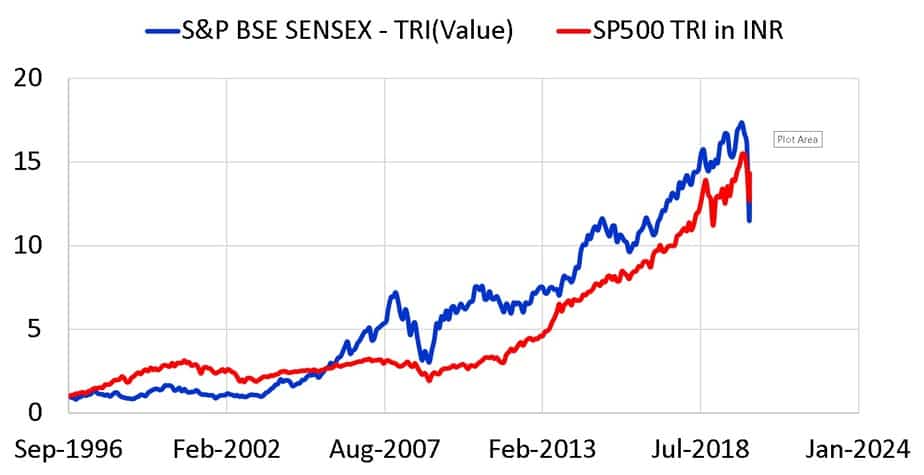
The full data set (monthly) is present above. Notice how the exchange rate has played a crucial role in reducing and moderating the risk of S &P 500 (in USD). Visibly, the red line is a lot less volatile than the blue.
Join 32,000+ readers and get free money management solutions delivered to your inbox! Subscribe to get posts via email! (Link takes you to our email sign-up form)
🔥Want to create a complete financial plan? Learn goal-based investing? Exclusive access to our DIY tools? Increase your income with your skills? Enjoy massive discounts on our robo-advisory tool & courses! 🔥
Instead of investing only in the Sensex (only the blue line) if we keep adding more and more of the red line, the volatility (for the above data set) will decrease. Returns will depend on timing luck. That is, it depends on the set of months over which the investment made.
Now consider a 15-year investment period ranging from Sep 1996 to Sep 2011 (1st run) and a 10% exposure to the S&P 500. We shall compare this with a 100% Sensex investment. The amount invested each month is assumed to increase each year at the rate of 5% (this will not impact the results).
The portfolio is rebalanced each year. Many investors assume “small exposures” such as 5% or 10% need not be rebalanced and can be left alone. This view is incorrect. This is how the 10% exposure to S&P 500 fluctuates each month during the 1st run with annual rebalancing.
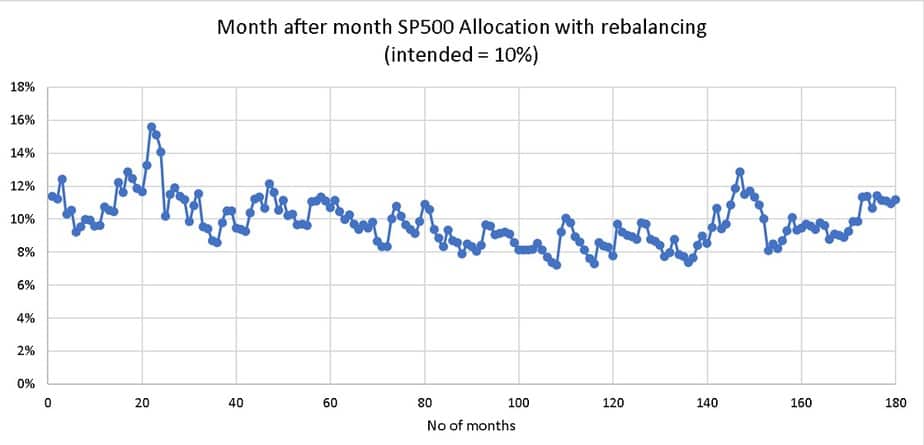
Notice how crucial rebalancing is in bring down (or up) the exposure to 10% periodically. If this was not done, the exposure would drift for the 1st run as shown below.

It should not be hard to imagine the impact of not rebalancing if there is 20% or 30% exposure to S &P 500. For the 1st run (Sep 1996 to Sep 2011) with annual rebalancing and 5% increase in investments, this is how the portfolios would evolve.
All images from this point on, incorrectly refer to Sensex as Nifty (force of habit). The error and inconvenience caused thereof is regretted.
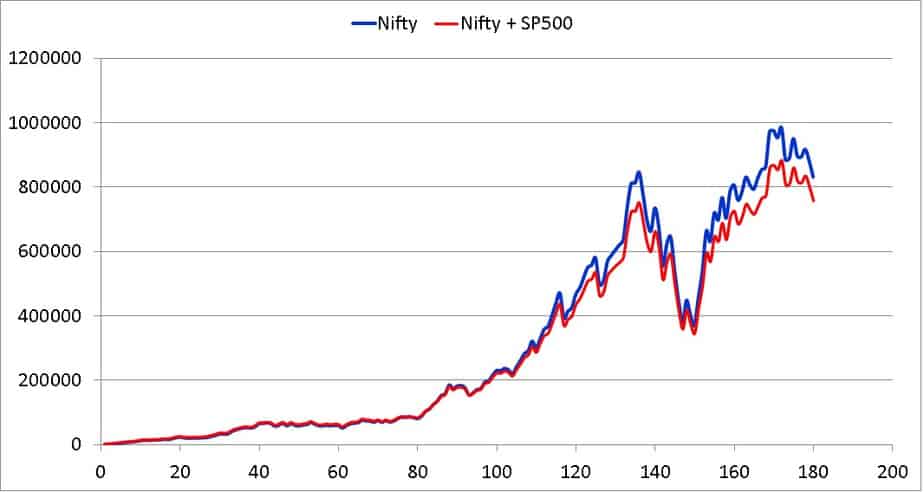
The XIRR for the Sensex-only portfolio in the 1st run is 16% and the 90% Sensex + 10% S&P 500 portfolio is 14.8%. We shall define a return difference (XIRR with S&P 500 – XIRR without) as -1.2%.
The 90% Sensex + 10% S&P 500 portfolio is 4% less volatility than the Sensex-only portfolio. That is, the beat is 96%. This data is for the 1st run.
The second run is from Oct 1996 to Oct 2011 (we have rolled over the 15-year window by one month. We compute the above nos, move on to the third round from Nov 1996 to Nov 2011 and so. We get 105 such runs.
The excess return obtained by including S&P 500 (XIRR with S&P 500 – XIRR without) and relative volatility (beta) for the 105 runs is shown below.
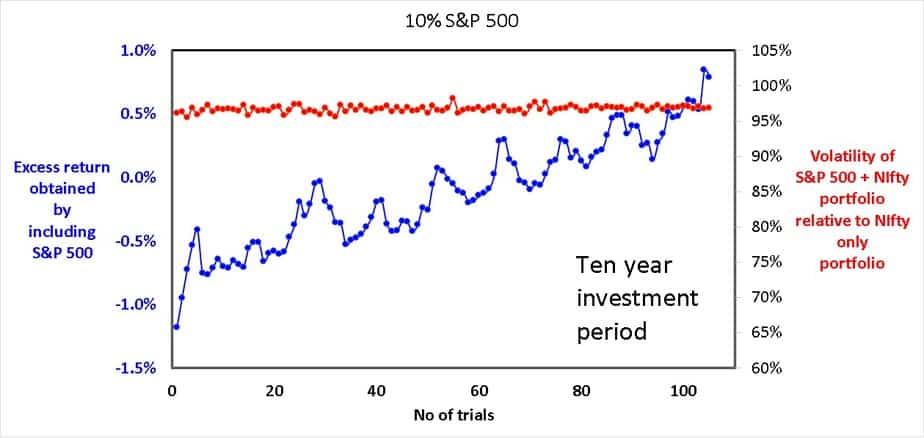
The average beta is 97%. Min excess return (worst benefit of including 10% S & P 500) is -1.18% and max excess return (best benefit of including 10% S & P 500) is 0.8%. Please note, tax and exit loads associated with rebalancing and tracking error and fund expense ratios are not included. This could conservatively take away about 2% of the final returns! Clearly a 10% S &P exposure does not have much benefit for the data set considered.
The impact of higher exposures for 10 and 15 year investment periods are shown below.
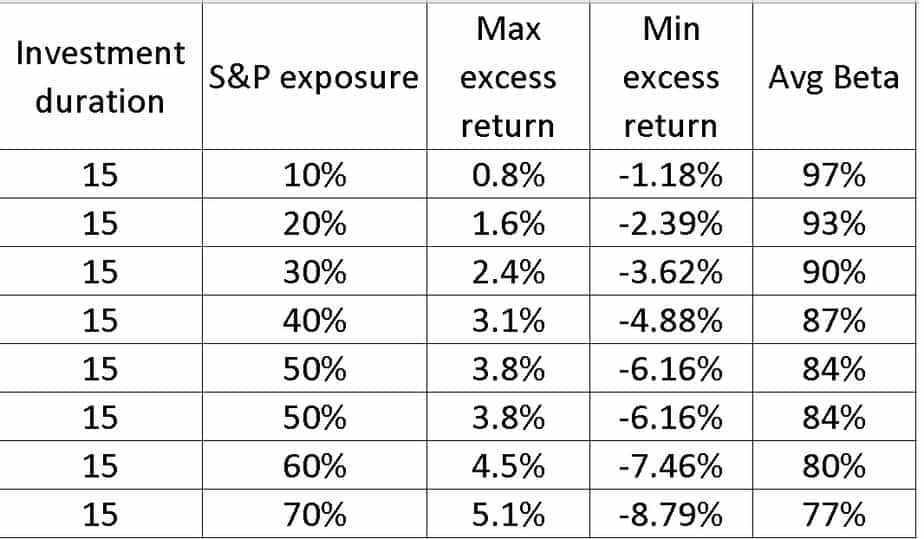
Notice that with higher and higher S&P 500 exposure, the portfolio becomes less and less volatile, but the spread bet the max benefit and min benefit increases. Even 30% exposure may not justify the maintenance costs (fund expense ratio, tax and exit load). Data for ten-year investment window is shown below.
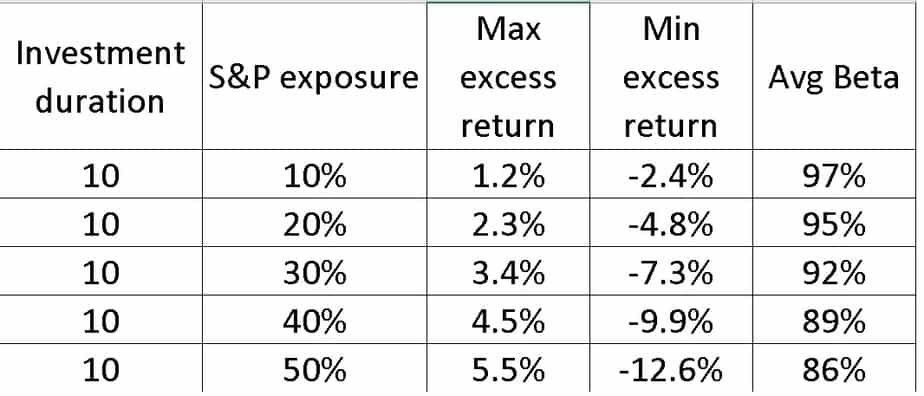
This spread is essentially a manifestation of the sequence of returns risk or in other words, sometimes things go your way and sometimes not! Just like timing the market, diversification lowers risk more often than not. However, the higher absolute reward is more of a coin toss.
Instead of annual rebalancing, one could rebalance based on moving averages to lower the return spread (lower not eliminate) but this would still require considerable exposure to justify the cost and labour. Read more: Timing the market will work but not the way we imagined!
Is separate US equity exposure via international funds worth all this trouble or should one stick with funds like Parag Parikh Long Term Equity or Axis Growth Opportunities and get “some” US stock exposure without the hassle of rebalancing and tax (but higher fund management fee)? Read more: Axis Growth Opportunities Fund vs Parag Parikh Long Term Equity Fund.
The primary benefit of including US equity is to lower portfolio risk and with the associated managed it can be achieved. However, most investors are lazy and do not bother to educate themselves that diversification could lower investment returns along with investment risk! They see something shiny and want a piece of that action. This can only lead to confusion and clutter. “Diversification benefits” require continuous maintenance.
Even if buying Indian mutual funds that invest in international stocks may not lower risk as efficiently as using dedicated international exposure, it is a whole lot easier! My vote is for the easier option.
🔥Enjoy massive discounts on our courses, robo-advisory tool and exclusive investor circle! 🔥& join our community of 7000+ users!
Use our Robo-advisory Tool for a start-to-finish financial plan! ⇐ More than 2,500 investors and advisors use this!
Track your mutual funds and stock investments with this Google Sheet!
We also publish monthly equity mutual funds, debt and hybrid mutual funds, index funds and ETF screeners and momentum, low-volatility stock screeners.





- Do you have a comment about the above article? Reach out to us on Twitter: @freefincal or @pattufreefincal
- Have a question? Subscribe to our newsletter using the form below.
- Hit 'reply' to any email from us! We do not offer personalized investment advice. We can write a detailed article without mentioning your name if you have a generic question.
Join 32,000+ readers and get free money management solutions delivered to your inbox! Subscribe to get posts via email! (Link takes you to our email sign-up form)
About The Author
 Dr M. Pattabiraman(PhD) is the founder, managing editor and primary author of freefincal. He is an associate professor at the Indian Institute of Technology, Madras. He has over ten years of experience publishing news analysis, research and financial product development. Connect with him via Twitter(X), Linkedin, or YouTube. Pattabiraman has co-authored three print books: (1) You can be rich too with goal-based investing (CNBC TV18) for DIY investors. (2) Gamechanger for young earners. (3) Chinchu Gets a Superpower! for kids. He has also written seven other free e-books on various money management topics. He is a patron and co-founder of “Fee-only India,” an organisation promoting unbiased, commission-free investment advice.
Dr M. Pattabiraman(PhD) is the founder, managing editor and primary author of freefincal. He is an associate professor at the Indian Institute of Technology, Madras. He has over ten years of experience publishing news analysis, research and financial product development. Connect with him via Twitter(X), Linkedin, or YouTube. Pattabiraman has co-authored three print books: (1) You can be rich too with goal-based investing (CNBC TV18) for DIY investors. (2) Gamechanger for young earners. (3) Chinchu Gets a Superpower! for kids. He has also written seven other free e-books on various money management topics. He is a patron and co-founder of “Fee-only India,” an organisation promoting unbiased, commission-free investment advice.Our flagship course! Learn to manage your portfolio like a pro to achieve your goals regardless of market conditions! ⇐ More than 3,000 investors and advisors are part of our exclusive community! Get clarity on how to plan for your goals and achieve the necessary corpus no matter the market condition is!! Watch the first lecture for free! One-time payment! No recurring fees! Life-long access to videos! Reduce fear, uncertainty and doubt while investing! Learn how to plan for your goals before and after retirement with confidence.
Our new course! Increase your income by getting people to pay for your skills! ⇐ More than 700 salaried employees, entrepreneurs and financial advisors are part of our exclusive community! Learn how to get people to pay for your skills! Whether you are a professional or small business owner who wants more clients via online visibility or a salaried person wanting a side income or passive income, we will show you how to achieve this by showcasing your skills and building a community that trusts and pays you! (watch 1st lecture for free). One-time payment! No recurring fees! Life-long access to videos!
Our new book for kids: “Chinchu Gets a Superpower!” is now available!


Must-read book even for adults! This is something that every parent should teach their kids right from their young age. The importance of money management and decision making based on their wants and needs. Very nicely written in simple terms. - Arun.Buy the book: Chinchu gets a superpower for your child!
How to profit from content writing: Our new ebook is for those interested in getting side income via content writing. It is available at a 50% discount for Rs. 500 only!
Do you want to check if the market is overvalued or undervalued? Use our market valuation tool (it will work with any index!), or get the Tactical Buy/Sell timing tool!
We publish monthly mutual fund screeners and momentum, low-volatility stock screeners.
About freefincal & its content policy. Freefincal is a News Media Organization dedicated to providing original analysis, reports, reviews and insights on mutual funds, stocks, investing, retirement and personal finance developments. We do so without conflict of interest and bias. Follow us on Google News. Freefincal serves more than three million readers a year (5 million page views) with articles based only on factual information and detailed analysis by its authors. All statements made will be verified with credible and knowledgeable sources before publication. Freefincal does not publish paid articles, promotions, PR, satire or opinions without data. All opinions will be inferences backed by verifiable, reproducible evidence/data. Contact information: To get in touch, use this contact form. (Sponsored posts or paid collaborations will not be entertained.)
Connect with us on social media
- Twitter @freefincal
- Subscribe to our YouTube Videos
- Posts feed via Feedburner.
Our publications
You Can Be Rich Too with Goal-Based Investing
 Published by CNBC TV18, this book is meant to help you ask the right questions and seek the correct answers, and since it comes with nine online calculators, you can also create custom solutions for your lifestyle! Get it now.
Published by CNBC TV18, this book is meant to help you ask the right questions and seek the correct answers, and since it comes with nine online calculators, you can also create custom solutions for your lifestyle! Get it now.Gamechanger: Forget Startups, Join Corporate & Still Live the Rich Life You Want
 This book is meant for young earners to get their basics right from day one! It will also help you travel to exotic places at a low cost! Get it or gift it to a young earner.
This book is meant for young earners to get their basics right from day one! It will also help you travel to exotic places at a low cost! Get it or gift it to a young earner.Your Ultimate Guide to Travel
 This is an in-depth dive into vacation planning, finding cheap flights, budget accommodation, what to do when travelling, and how travelling slowly is better financially and psychologically, with links to the web pages and hand-holding at every step. Get the pdf for Rs 300 (instant download)
This is an in-depth dive into vacation planning, finding cheap flights, budget accommodation, what to do when travelling, and how travelling slowly is better financially and psychologically, with links to the web pages and hand-holding at every step. Get the pdf for Rs 300 (instant download)